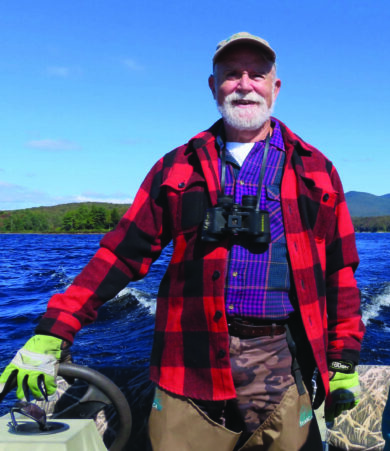
© Nicki Steel
Like many volunteers on VCE projects, this year’s winner of the Julie Nicholson Community Science Award turned his curiosity about nature into a decades-long passion. “I just knew what a loon looked like—I had no idea where they were or how long they nested.” Henry Dandeneau got his start with loons while working at the Deerfield River
Power Company. In 1992, the Federal Energy Regulatory Commission (FERC) wanted to begin relicensing some of southern Vermont’s facilities, including the dam at Somerset Reservoir. However, officials at other government agencies swiftly intervened, citing concerns over the loons nesting in the reservoir.
“At the time, my boss told me that the most important part of my job was compliance with our FERC license,” Henry said. “And I told him that I agreed one hundred percent because without our license, we couldn’t operate. However, I needed his clearance to start working with and learning about Vermont’s loons because I had no hope of keeping us in compliance if I knew nothing about the loons.”
As the process began, Henry quickly became enchanted by these charismatic birds, and what started as a quest to understand the Somerset pair drove Henry to get involved with more loon work. He soon joined the annual LoonWatch in July and visited Somerset Reservoir nearly every day to watch for the birds. “I think we were in total compliance every year I was in charge,” Henry said.
Since those early days, Henry has dedicated 28 years as a loon monitor. To VCE loon biologist Eric Hanson, Henry is affectionately known as “the Southern Loon Biologist.” “VCE is so fortunate to be affiliated with a person like Henry,” Hanson says. “I admire his passion for adventure, his love of wildlife, and his sense of responsibility to get a job done well.”
Henry tracks the four loon pairs currently inhabiting the 1,600-acre Somerset Reservoir almost weekly (a 6-8 hour endeavor). He drives, hikes, and boats for over 20 hours on and around
LoonWatch day to survey two huge reservoirs and another half dozen small ponds. He also visits many other smaller lakes throughout the season as the loon population has expanded.
It’s no understatement to say that Henry’s contributions have had a large impact on VCE’s Vermont Loon Conservation Project. In the weeks from mid-May to mid-July, he is usually out monitoring loons two to three days per week and covers four primary water bodies. When a loon is in trouble, he is usually one of the first called in to help, sometimes as the primary responder.
“I typically only help with the southern Vermont rescues,” Henry explained. “However, I’ll go pretty much anywhere in Vermont with enough notice.”
Over the years, Henry has amassed just as many thrilling stories of loon encounters as he has bird knowledge. From witnessing unusual behavior to finding island-bound roosters, every venture as
a loon monitor has yielded remarkable discoveries.
___________________________
The Julie Nicholson Community Science Award honors Julie Nicholson’s extraordinary passion and commitment to birds and wildlife conservation through her many years of tireless work as a community scientist. It is presented annually to an individual who exemplifies Julie’s dedication to the cause of community science and conservation.
